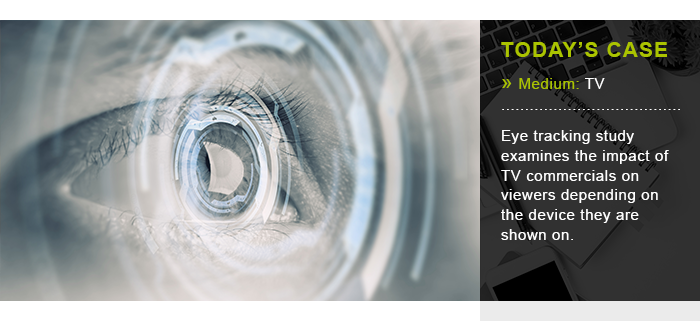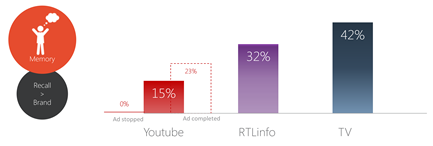|
|
||||||
| Business case studies | No 173 - 14.04.2017 |
 |
Eye tracking study proves the stronger impact of TV ads compared to online video There are numerous studies about TV ads, but only few of them focus on the attitude of the viewers watching those ads. Does their behaviour change depending on the device they are watching the TV ads on? Are they getting frustrated by the ads? This week’s egtabite brings answers to these questions thanks to a study conducted by IP Belgium with the institute Mind Insights. The aim of the study was to rigorously examine the impact of TV commercials on viewers depending on the device they are shown on. The use of eye tracking To answer the question “how does ad effectiveness vary according to the platform?”, IP selected 84 people aged between 20 and 60 and exposed them to three different viewing experiences: television, YouTube and the news website RTL info. The viewers could choose to watch different fun blooper videos (chosen for their fun yet neutral nature), which were preceeded by an unsolicited 20-second ad. The ads were selected prior to the study to make sure they were not already known by the participants, and that all of them had the same emotional appeal. The viewing experience was as close to real conditions as possible (i.e. on YouTube the viewers had the possibility to skip the ad after 5 seconds, and on the RTL info website the ad was shown with an embedded countdown). The researchers analysed the gaze direction of the viewer, the frustration caused by the ad and what the viewer remembered of the ad. Each participant successively watched all three media in alternating order. The attitude of the participants was measured by an eye-tracking device, recording the gaze of the viewer to precisely analyse where their attention went as the commercial was aired. The results The first observation revealed that the viewer’s attention strongly varies depending on the medium. Television is the medium on which the attention given to an ad is the biggest, reaching an attention rate of 99%. This attention drops to 69% when the ad is being watched on an information website and to 51% when it is being watched on YouTube. A third of people decided to skip the commercial on YouTube, which resulted in an attention level of 17% for these skipped ads and a 0% brand recall. When the ad was actually watched to the end, however, YouTube’s brand recall reached 23%, a number easily surpassed by RTL’s information website with a brand recall of 32% and almost doubled by television with a recall of 42%. Additionally, the ad tolerance proved to be stronger on TV. The viewers were twice as frustrated when the ad was online than when it was on TV. The level of frustration remained the same on YouTube and on the website, regardless of whether it could be skipped or not. Why does this matter to egta members? Contrary to the belief of many in the ad industry, not all video is created equal. Research like this once again reinforces TV's strength and its unique position where ad tolerance and viewability reach levels unattainable by online video. Television offers a brand-safe and efficient environment and is therefore the ideal premium context for brands to showcase their products. |
|
| egta - 22, Rue des Comédiens, boîte 4 - 1000 Brussels - T: + 32 2 290 31 31 - www.egta.com |




